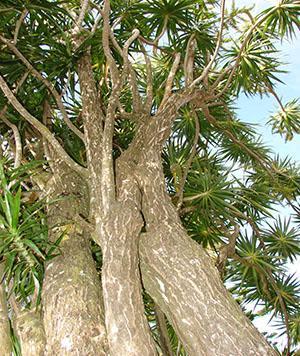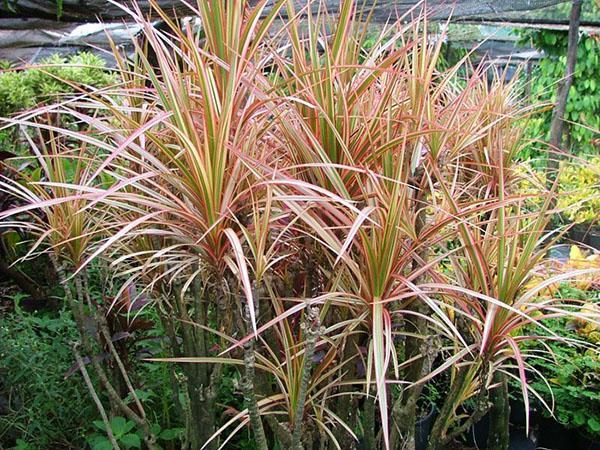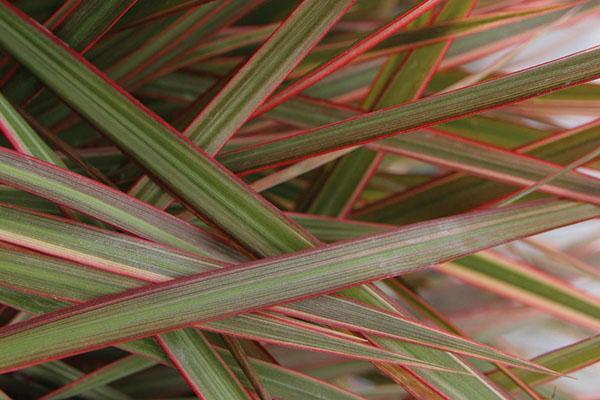All about dracaena marginata and her care
 Of the hundreds of dracaena species, only a few are able to live at home. Among the most famous varieties are dracaena marginata or bordered dracaena. The plant native to the island of Madagascar is known in the world as Dracaena marginata or Madagascar Dragon tree.
Of the hundreds of dracaena species, only a few are able to live at home. Among the most famous varieties are dracaena marginata or bordered dracaena. The plant native to the island of Madagascar is known in the world as Dracaena marginata or Madagascar Dragon tree.
The mention of the tree in the name is well deserved. At home, wild specimens are not limited to the usual 50-150 cm for indoor crops, but grow up to 3-5 meters in height. But, as at home, dracaena marginata does not differ in the splendor of the crown. Fast-growing shoots, after the elongated leaves have fallen off, remain naked, they branch reluctantly and rarely, and only at the top one can observe a cap of hard green or variegated foliage.

Today, flower growers have varieties of dracaena marginata at their disposal, the leaf plates of which are covered with longitudinal green, white and even pink stripes of varying saturation.
Depending on the range, such specimens may be called Dracaena Tricolor, Bicolor or Colorata. In the latter variety, the red-pink color of the leaves is dominant, which gives the plant a special originality. But in the Magenta variety, the red color appears as a thin strip along the edge of the white-green leaf.
 As you can see in the photo, dracaena marginata is distinguished by rather dense wiry foliage, adapted for living in open sunny places, as well as in conditions of a lack of moisture.
As you can see in the photo, dracaena marginata is distinguished by rather dense wiry foliage, adapted for living in open sunny places, as well as in conditions of a lack of moisture.
Dracaena marginata at home
 Forced in nature to survive not in the most comfortable conditions, dracaena feels great in a pot culture. It is unpretentious, plant care cannot be called labor-intensive, and therefore the plant enjoys the well-deserved attention of indoor plant lovers.
Forced in nature to survive not in the most comfortable conditions, dracaena feels great in a pot culture. It is unpretentious, plant care cannot be called labor-intensive, and therefore the plant enjoys the well-deserved attention of indoor plant lovers.
Quite large specimens of the Madagascar dragon palm can be found in residential and office premises, and if the dracaena marginata is in good conditions, then in the house it can grow up to natural three meters and becomes like a slender tree.
In addition to the fact that the plant is not capricious and original, interest in it is maintained due to the ability of dracaena to effectively purify the air and bring peace and mental well-being to the inhabitants of the house. The flower in the room imperceptibly affects the energy, charges with optimism, raises the tone.
Features of caring for dracaena marginata at home
 Dracaena marginata, pictured, requires very little attention to itself, so it can be grown both by novice growers, and in places where the plant receives only occasional care, for example, in offices and in public institutions:
Dracaena marginata, pictured, requires very little attention to itself, so it can be grown both by novice growers, and in places where the plant receives only occasional care, for example, in offices and in public institutions:
- Culture is not afraid of high temperatures.
- Indoor dryness is also not critical for plants from hot, dry climates.
- Varieties with green leaves are the most unassuming. They easily get used to being in the shade, but variegated varieties are best exposed to bright, but diffused light. In this case, the unusual color of the leaf plates is fully manifested.
And yet, caring for dracaena marginata at home has its own characteristics that have to be taken into account.
The vertical shoots of the plant are quite fragile, therefore they need reliable support.This rule is especially important if there is a large specimen in the room, the fall of which is dangerous for the residents of the house.
Dracaena marginate leaves are susceptible to damage, and violation of the integrity of one leaf plate leads to a growth retardation of the entire plant. Therefore, it is more reasonable to remove such foliage immediately.
 The root system of dracaena does not tolerate excessive moisture, which is fraught with the development of putrefactive processes for the plant and death. Watering when caring for dracaena marginate at home, as in the photo, is moderate. In order not to wash out the earthen lump, use a scattering nozzle and use well-settled warm water:
The root system of dracaena does not tolerate excessive moisture, which is fraught with the development of putrefactive processes for the plant and death. Watering when caring for dracaena marginate at home, as in the photo, is moderate. In order not to wash out the earthen lump, use a scattering nozzle and use well-settled warm water:
- In the summer, the pet is watered more abundantly and more often, on especially hot days the crown can be sprayed.
- In winter, the interval between waterings is increased and it is made sure that the soil has time to dry out at least 3 cm deep before the next procedure.
To avoid rotting and death of roots will help regular aeration of the soil, which is carried out with the help of surface loosening at least 1 time per month.
This contributes to a better supply of oxygen to the roots and the access to them of nutrients. Intensive growth of dracaena marginate in summer requires support. Her plant gets in the form complex fertilizer with a frequency of once every two weeks. In winter, the need for micro- and macronutrients is less, so you can fertilize the crop once a month or according to its well-being.
 In winter, when the heating is running, the air is dry and the growth rate is low, the tips of the leaves can dry out. To prevent the process and create the proper conditions for a green pet:
In winter, when the heating is running, the air is dry and the growth rate is low, the tips of the leaves can dry out. To prevent the process and create the proper conditions for a green pet:
- do not put the marginate dracaena, as in the photo, next to the heating devices;
- it is useful to give the plant a warm shower or wipe the foliage with a damp towel daily.
Due to the sensitivity of the leaves, in no case should you cut off or break off already dried tips.
How to prune dracaena magrinata and replant the plant?
 Having brought a plant to your home from a flower shop, it is important to examine it and decide on the fate of the flower. The transplant of dracaena marginate after purchase can be postponed if the plant purchased in winter or autumn is in good condition and there is enough soil for growth. Unfortunately, this is not always the case. Excessively wet soil or roots sticking out of the pot are a sure sign that you cannot do without urgent measures!
Having brought a plant to your home from a flower shop, it is important to examine it and decide on the fate of the flower. The transplant of dracaena marginate after purchase can be postponed if the plant purchased in winter or autumn is in good condition and there is enough soil for growth. Unfortunately, this is not always the case. Excessively wet soil or roots sticking out of the pot are a sure sign that you cannot do without urgent measures!
But when buying a flower in the spring, when all living things start to grow, dracaena can be safely transferred to a new loose substrate in two weeks, having previously selected a suitable pot.
Since the plant grows quickly and is tall, it is better to give preference to a stable, heavy pot with a wide base, which will ensure the safety of both plants and people.
Long bare stems of dracaena lose their decorative effect after a while, and the plant requires too much space. How to trim dracaena marginata and when is it better to do it?
This procedure is one of the necessary measures for caring for dracaena marginata at home. It is carried out by:
- to limit the vertical growth of shoots;
- to activate tillering;
- to make the flower more compact.
 In dracaena, the top of the stem is cut off, and the cut site is treated with crushed charcoal or activated carbon. For large trunks, use candle paraffin or garden var. The top of the shoot is covered with a bag or film. With further care, additional buds gradually wake up on the bare stem, and the formation of new shoots begins. The remaining tip is also easily rooted and becomes an independent plant.
In dracaena, the top of the stem is cut off, and the cut site is treated with crushed charcoal or activated carbon. For large trunks, use candle paraffin or garden var. The top of the shoot is covered with a bag or film. With further care, additional buds gradually wake up on the bare stem, and the formation of new shoots begins. The remaining tip is also easily rooted and becomes an independent plant.
 Pruning, like the reproduction of dracaena, is done in the spring. In addition to the apical shoots, to obtain new young flowers, they use pieces of stems about 10-15 cm long, air layers, as well as children formed at the base of an old specimen of dracaena marginata, as in the photo.
Pruning, like the reproduction of dracaena, is done in the spring. In addition to the apical shoots, to obtain new young flowers, they use pieces of stems about 10-15 cm long, air layers, as well as children formed at the base of an old specimen of dracaena marginata, as in the photo.
Rooting is carried out in a mixture of sand and peat with the addition of pieces of charcoal and sphagnum. The best results can be obtained in a greenhouse.
It takes no more than 30 days to form a full-fledged root system. In the future, young dracaena are transplanted at intervals of 2-3 years, carefully transferring the earthen lump into a pot a couple of centimeters larger than the previous one. To plant a plant, drainage and light well-aerated soil are required, for example, a ready-made mixture for palm trees and dracaena with the inclusion of fine red brick, sand and coal.
On the Video about caring for dracaena, music plays loudly, speaking almost inaudibly ((
Hello, tell me please, the leaf of the dracaena cracked, what should I do? Eliminate or leave, reviews are different, I can't decide….
It is better to insert a photo of your plant.
Question .. where to put the dracaena pot, south, north, west or no difference?
Hello! We have a problem with dracaena, at the top the leaves began to turn yellow and fall out and wither with a small stalk, one was cut off, now the next ones start, what to do, please help
Analyze if the conditions for keeping the flower have changed recently. Dracaena leaves begin to turn yellow, fall off and wither if the room is too cold or there is a draft. Excessive watering and waterlogging also cause severe damage to the plant. Leaf fall begins with dracaena disease. I would take it out of the pot and take a good look at the roots. It is likely that they may already start to rot, and from this the leaves disappear. Inspect, trim off all affected parts, completely change soil and pot. Or wash the container well with a solution of potassium permanganate. Treatment of dracaena with a fungicide does not hurt, but there is rot - then it is even required. You can also trim the top off if it is completely bald. Although this is not the season for a haircut, it will help stop the disease so that it does not affect the entire stem.